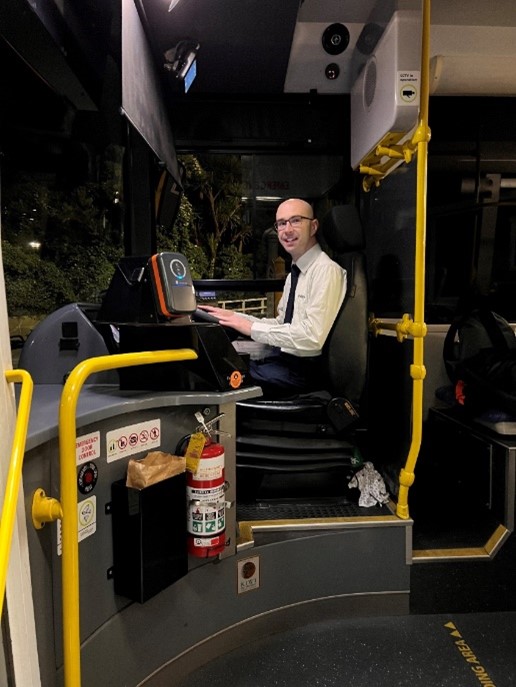On your bike: NZTA’s Industry Alert to Bus Operators in relation to bike racks.
Craig Tatley, a solicitor in the Litigation team at Gibson Sheat, has a unique perspective on the challenges facing the passenger transport industry, as he regularly drives as an Urban Bus Driver in Wellington.
Bike racks on urban buses are a feature of urban buses in almost every city in New Zealand outside of Auckland. They are a fantastic initiative for encouraging multi-modal public transportation, enabling bike users to effectively use public buses safely. In response to safety concerns about bus headlamp visibility at night when bike racks are in use, the New Zealand Transport Agency | Waka Kotahi (NZTA) have issued an Industry Alert, stating that bike racks can obscure the illumination provided by the headlamps on some buses at night when bike racks are in use.
The Industry Alert states that bus operators should assess whether each particular bus with a bike rack is so affected, and if a bus is affected, bike rack usage on that bus should be limited to the hours of daylight until the bus is so modified so that the bus complies with the relevant lighting requirements.
The NZTA’s advice in relation to bike rack usage does not provide a defence to any charge that may arise if, for example, a Police officer were to decide that with the bike rack in use in daylight, the bus no longer met the required standard for a Certificate of Fitness (CoF).
Vehicle Standards
- Vehicles must have headlamps that provide enough illumination to fulfil the purpose of that particular lamp, and to enable that vehicle to be safely operated on the road. Vehicles that are operated on the road must be maintained to the level required for that vehicle to be issued it’s required CoF (which are, broadly speaking, that a vehicle meets the required standard and can be safely operated), at all times (CoF Standard). In summary, in relation to vehicle headlamps, a vehicle must maintain it’s headlamp performance at all times so that vehicle will meet the CoF Standard.
- If a vehicle is not operated so that it meets the CoF Standard, the operator (Who can be both the driver, and the owner of the vehicle) is liable to a fine of $2,000. Police also have the power to prohibit a vehicle from being used until it is compliant with the CoF Standard.
Exemptions from the CoF Standard
- There are two regimes within the myriad Land Transport legislation that enable the Director of the NZTA (the Director) to either:
-
- Exempt a particular vehicle, or class of vehicles from specific requirements (which could relate to the CoF Standard); or
- Provide that a specific vehicle may be issued with an ‘in-service conditional permit’, which enables that vehicle to be operated without a CoF under particular conditions (which may involve for example, that a vehicle is not to be driven at night) if a vehicle inspector (or the Director, who can take that function) determines that the vehicle can be safely operated with those conditions.
- The Director has taken neither of these steps. There are particular notification requirements for class exemptions that have not been met, and no class exemption is listed on the relevant page of the NZTA website in relation to urban bus bike rack headlight requirements (Where an exemption is provided for urban bus bike racks in relation to bus dimensions).
- The language of the inspection requirements that need to be met to issue an ‘in-service conditional permit’ indicate this is issued on a vehicle-by-vehicle basis, rather than on a class, or vehicle type basis. Additionally, this ‘in-service conditional permit’ must be carried in the vehicle (much as a CoF must be displayed).
Where does this leave Bus Operators?
- Absent an exemption or an in-service conditional permit, buses, like all vehicles (subject to a CoF inspection), must meet the CoF Standard at all times they are operated on the road.
- Headlamps are used outside the hours of darkness, for example during rainfall, in tunnels, or other periods of low light. If a Police officer considered, during the hours of daylight, that a bus headlamp provided insufficient illumination (or was not fit for purpose), due to the operation of the bike rack, they could potentially charge the operator (driver or owner) of that bus with failing to operate that bus in accordance with the CoF Standard.
- Without the legislative force of an exemption or an in-service conditional permit, the NZTA’s advice provides no legal defence to bus operators who permit bike racks to be used during the day.
- Operators are likely to consider they have been left between a rock and a hard place; Public Transport Authority urban bus contracts require the provision of (and implicitly, the ability to use) bike racks on urban buses in particular regions, while operators need to comply with the law. If they have not already, operators should raise this issue with the relevant Public Transport Authority.
Gibson Sheat have expertise in all legal matters that relate to road transport. If you would like to discuss any issues that relate to this article, or about road transport legal issues more generally, please do not hesitate to contact Craig Tatley.


